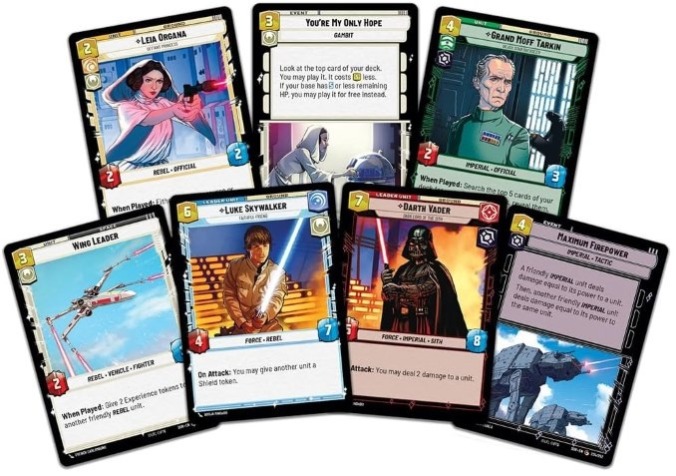Gather The Force in the Star Wars: Unlimited Collectible Card Game

Star Wars: Unlimited—Spark of Rebellion is just the latest effort to take the Magic: the Gathering formula to another thematic universe, following the wildly successful 2023 release Disney Lorcana from Ravensburger. And since the expanded Star Wars universe provides a tremendous amount of content for the public’s inevitable thirst for more packs, there’s already huge interest in the game and a thriving secondary market. It’s not my type of game experience, but I can see why this one has caught on so quickly.
I’ve never been a deckbuilder guy, particularly not of the sort known as collectible card games, or CCGs, although various companies have given their own names to the genre. These games incorporate two things I don’t generally like in games: the need to continue buying or acquiring game components to keep up with the competition, and the need to do advance preparation before playing by building and honing your deck. (In that way, it reminds me of playing fantasy baseball, a hobby that took up a huge amount of my time from the year I graduated high school until baseball became my full-time job 13 years later.) These attributes are also a big part of the genre’s success—people love the collecting, love the hunt for new or rare cards, love playing around with their decks to try to find the ideal card combinations.
The two starter packs each contain a Leader—Luke Skywalker or Darth Vader—as well as a base card, a deck of 50 cards to be drawn and played over the course of the game, and three shield/experience upgrade cards. The goal is to destroy your opponent’s base, each of which has 30 hit points in the starter packs, before they destroy yours. Your Leader starts the game in play as a static card that can’t attack or be attacked, with some modest power it can use as an action each turn, but once you meet a specific criterion you can then put it into play, where it becomes quite powerful—but where your opponent can also defeat it and send it back to its weaker, static mode for the remainder of the game.
The game play itself is pretty simple to learn, although the terms and icons are less so and make the cards a bit cluttered. Each player starts the game by shuffling their deck and drawing six cards, then placing two of them face-down as ‘resources,’ which determine the number and strength of actions they may take each turn. The player cedes the right to use the powers or actions on any card played as a resource, so it’s a significant choice for the start of the game. Each player may choose once to discard their initial six-card draw and start over, but they’re stuck with the second sextet.
-

-

-

-

-

-

-

-

-

-

-

-

-

-

-

-

-

-

-

-

-

-

-

-

-

-

-

-

-

-

-

-

-

-

-

-

-

-

-

-









































